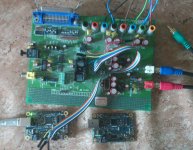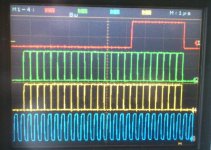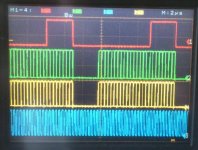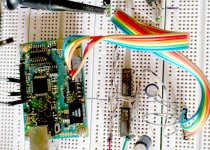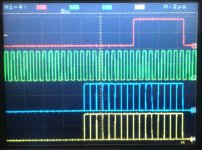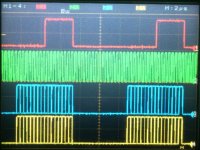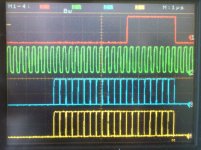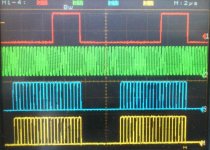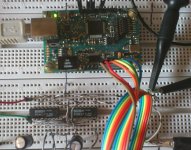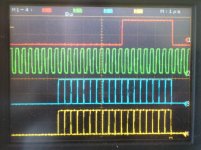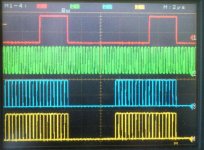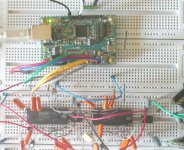Hi,
After exchanging private messages with forum guys, I understand that it will be better if I open a new thread for PCM1704 and in general for DACs with separate data channels. The idea is these DACs to be interface directly to low jitter source. In that way they can work in NOS mode but one can use computer resource for oversampling or digital filtering (JRiver). http://www.diyaudio.com/forums/digital-source/236028-xmos-dsd-384-khz-32bit-usb.html
At the moment protocols for PCM1704, PCM56 and PCM63 are implemented. For now successfully tested is only protocol for PCM1704 using demo board DEM_DAI1704 (http://www.ti.com/lit/ug/slau068/slau068.pdf). Thanks to Angel this demo board was used. Sampling frequencies from 44.1 to 384 kHz are achieved (for now). Pictures are for PCM1704. For better seeing the data, oscillograms are made in persistence mode of 50 sweeps. Protocols for PCM56 and PCM63 haven’t been tested yet (I will provide information after successful test).
To be able to use the same PCB, without further alteration, the second data channel is outputted from the SPDIF output pin, i.e. in this configuration one could not be able to use the SPDIF output. SPDIF output can be configured through existing pin.
For some time there are slightly changes in the used hardware (PCB board on the left side), but they are for unification of the components and it’s been added a divider for achievement of 11.2896 MHz and 12.288MHz. Some time both XMOS PCBs are going to be available. Both XMOS PCBs have the same features except the additional divider.
I’m open to any new proposal for this project.
Regards,
Joro
After exchanging private messages with forum guys, I understand that it will be better if I open a new thread for PCM1704 and in general for DACs with separate data channels. The idea is these DACs to be interface directly to low jitter source. In that way they can work in NOS mode but one can use computer resource for oversampling or digital filtering (JRiver). http://www.diyaudio.com/forums/digital-source/236028-xmos-dsd-384-khz-32bit-usb.html
At the moment protocols for PCM1704, PCM56 and PCM63 are implemented. For now successfully tested is only protocol for PCM1704 using demo board DEM_DAI1704 (http://www.ti.com/lit/ug/slau068/slau068.pdf). Thanks to Angel this demo board was used. Sampling frequencies from 44.1 to 384 kHz are achieved (for now). Pictures are for PCM1704. For better seeing the data, oscillograms are made in persistence mode of 50 sweeps. Protocols for PCM56 and PCM63 haven’t been tested yet (I will provide information after successful test).
To be able to use the same PCB, without further alteration, the second data channel is outputted from the SPDIF output pin, i.e. in this configuration one could not be able to use the SPDIF output. SPDIF output can be configured through existing pin.
For some time there are slightly changes in the used hardware (PCB board on the left side), but they are for unification of the components and it’s been added a divider for achievement of 11.2896 MHz and 12.288MHz. Some time both XMOS PCBs are going to be available. Both XMOS PCBs have the same features except the additional divider.
I’m open to any new proposal for this project.
Regards,
Joro
Attachments
Hi,
Protocol for PCM56 and DAC-s compatible with it (16-bit) has been successfully tested. The aim was to verify the protocol, so it wasn't used reconstruction filter, as an I/V integrated operational amplifier was used. Fs frequencies tested: 44.1kHz to 384kHz.
Pictures are for PCM56. For better seeing the data, oscillograms are made in persistence mode of 50 sweeps.
Regards,
Joro
Protocol for PCM56 and DAC-s compatible with it (16-bit) has been successfully tested. The aim was to verify the protocol, so it wasn't used reconstruction filter, as an I/V integrated operational amplifier was used. Fs frequencies tested: 44.1kHz to 384kHz.
Pictures are for PCM56. For better seeing the data, oscillograms are made in persistence mode of 50 sweeps.
Regards,
Joro
Attachments
Hi,
JRiver - up to 384kHz 16/24/32, WASAPI 192kHz 16/24, embedded resources of Win7 192kHz 16/24 and others.
Regards,
Joro
What are you using for PC oversampling? ...
JRiver - up to 384kHz 16/24/32, WASAPI 192kHz 16/24, embedded resources of Win7 192kHz 16/24 and others.
Regards,
Joro
...
have you tested with windows8 64bit ? W8 sound better and less dropout in my set up...
Hi,
For now, I listen with Win x64, but after your recommendation I will make comparison to Win8.
Regards,
Joro
Hi Frank
Very nice you like my creation, i'm glad to hear that.
It's called the "AudiophileOptimizer"
Joro, if you are interested you can find more details on my Homepage (Highend-AudioPC.com)
Thanks,
AudioPhil
Very nice you like my creation, i'm glad to hear that.
It's called the "AudiophileOptimizer"
Joro, if you are interested you can find more details on my Homepage (Highend-AudioPC.com)
Thanks,
AudioPhil
I think the main purpose of Joro's board is to minimise differences between OS's, the influence of running services, processes, player software and hardware. There is indeed still something to be gained for some completely obscure reason, but honestly, it's slim pickings at this stage.
Per example I fail to hear any difference at all by adjusting the latency of the driver. Previously this would be a very critical setting... It is interesting if the annoyance of running server software would still be worth it with this board.
Per example I fail to hear any difference at all by adjusting the latency of the driver. Previously this would be a very critical setting... It is interesting if the annoyance of running server software would still be worth it with this board.
Hello
i would offer a single Activation-Key for a member with this board. The only obligation would be to follow the guide exactly as stated. please feel free to read the reviews, they are worth reading: Highend-AudioPC.com | Reviews you can click on every single one of them to read the original posting on the internet.
Thanks,
AudioPhil
i would offer a single Activation-Key for a member with this board. The only obligation would be to follow the guide exactly as stated. please feel free to read the reviews, they are worth reading: Highend-AudioPC.com | Reviews you can click on every single one of them to read the original posting on the internet.
Thanks,
AudioPhil
That's certainly a very fair offer. Reviews, otoh, are only meaningful within the context of a particular usb-dac. Most commercial solutions have not been designed with particular attention towards clock integrity or isolation and as a consequence are extremely sensitive to software and hardware induced jitter.
This is certainly an interesting topic, only this thread is about something else entirely
Maybe a new thread would be a more appropriate venue for this discussion.
This is certainly an interesting topic, only this thread is about something else entirely
Maybe a new thread would be a more appropriate venue for this discussion.
Till now I've bought two Joro boards to be used at home and during work traveling.
At the beginning I've been very happy to ear my preferred classical music via this xmos implementation.
Then I've tried the Audiophile Optimizer and I can assure I was schocked by new sound, liquid and distortion free.
Now you think there's little to be gained from Os optimizing but, believe me, reality is different. Me too thought the same prior to use win 2012 and Optimizer.
It's as a whole different world!
I hope you can try by yourselves.
Frank
p.s. All these thought are IMHO!
At the beginning I've been very happy to ear my preferred classical music via this xmos implementation.
Then I've tried the Audiophile Optimizer and I can assure I was schocked by new sound, liquid and distortion free.
Now you think there's little to be gained from Os optimizing but, believe me, reality is different. Me too thought the same prior to use win 2012 and Optimizer.
It's as a whole different world!
I hope you can try by yourselves.
Frank
p.s. All these thought are IMHO!
I think the main purpose of Joro's board is to minimise differences between OS's, the influence of running services, processes, player software and hardware. There is indeed still something to be gained for some completely obscure reason, but honestly, it's slim pickings at this stage.
Per example I fail to hear any difference at all by adjusting the latency of the driver. Previously this would be a very critical setting... It is interesting if the annoyance of running server software would still be worth it with this board.
It's called the "AudiophileOptimizer"
Hello. How does it compare with Fidelizer (free)?
Very interested in this thread as I have a 1704 DAC.
...You should try win 2012 server with AudioPhiler Optimize...
Hi,
Thanks for the advice. Could you please tell me if there was a difference between Win7 and Win 2012 without AudioPhiler Optimize?
...Joro, if you are interested you can find more details on my Homepage...
I looked at your page. What you made sounds very interesting. I can test it and organize a hearing with Bulgarian audio fans, but I think that it will be better someone who is not bound to this device to test the Audiophile Optimizer.
Protocol for PCM63 and DAC-s compatible with it (20-bit), also protocol for PCM61 and DAC-s compatible with it (18-bit) have been successfully tested. The aim was to verify the protocols, so it wasn't used reconstruction filter, as an I/V integrated operational amplifier was used. Fs frequencies tested: 44.1kHz to 384kHz.
Pictures are for PCM63 and PCM61. For better seeing the data, oscillograms are made in persistence mode of 50 sweeps.
Regards,
Joro
Attachments
Yes, ther's a lot of clarity and liquidity to be gained form Win 2012 Server and Audiophile Optimizer.
I had Win7 installed in my pc but now I don't use it anymore.
I know that you have to pay for a new OS and Philip Optimizer Sw BUT, for me, it's worth the extra cost. It's incredible!
Frank
I had Win7 installed in my pc but now I don't use it anymore.
I know that you have to pay for a new OS and Philip Optimizer Sw BUT, for me, it's worth the extra cost. It's incredible!
Frank
Hi,
Thanks for the advice. Could you please tell me if there was a difference between Win7 and Win 2012 without AudioPhiler Optimize?
I looked at your page. What you made sounds very interesting. I can test it and organize a hearing with Bulgarian audio fans, but I think that it will be better someone who is not bound to this device to test the Audiophile Optimizer.
Regards,
Joro
Sorry,
I misundertood your answer! It's not so easy to be still smart after a day at work )
)
Anyway going from Win7 to Win 2012 Server you can appreciate a better sound overall.
I only want to underline that the real gain was obtained with the Optimizer Sw. You can't believe how much audio data is affected by the Os.
In the meanwhile, waiting to try your Ak4396 dac, I'd like to say thank you for your kind support about Xmos module.
It's a pleasure to deal with you and your product is a real winner.
Frank
I misundertood your answer! It's not so easy to be still smart after a day at work
Anyway going from Win7 to Win 2012 Server you can appreciate a better sound overall.
I only want to underline that the real gain was obtained with the Optimizer Sw. You can't believe how much audio data is affected by the Os.
In the meanwhile, waiting to try your Ak4396 dac, I'd like to say thank you for your kind support about Xmos module.
It's a pleasure to deal with you and your product is a real winner.
Frank
Yes, ther's a lot of clarity and liquidity to be gained form Win 2012 Server and Audiophile Optimizer.
I had Win7 installed in my pc but now I don't use it anymore.
I know that you have to pay for a new OS and Philip Optimizer Sw BUT, for me, it's worth the extra cost. It's incredible!
Frank
What sucks about computer audio and USB in particular is all the noise, just measure an FFT of any USB dac and look at the spike at 10k hz, the computer OS isn't the issue its isolating the ground and power supply. Thinning down the OS and MB usage is just not going after root cause.
- Status
- This old topic is closed. If you want to reopen this topic, contact a moderator using the "Report Post" button.
- Home
- Source & Line
- Digital Line Level
- XMOS direct drive PCM1704, PCM56, PCM63 and others for NOS mode or PC oversampling
